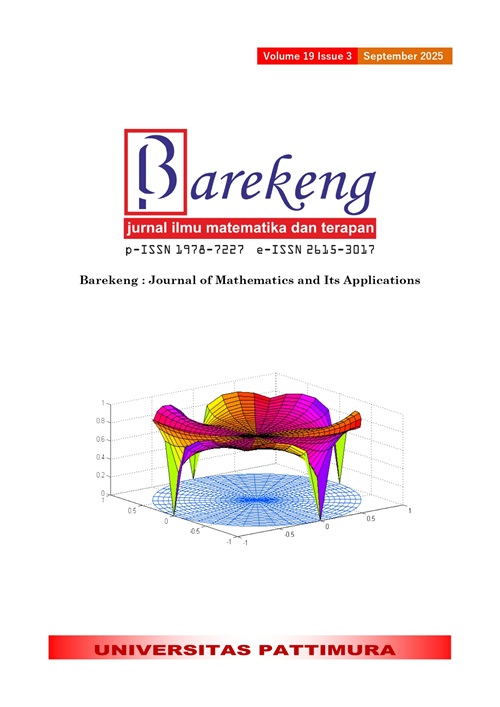COMBINING FUZZY ANP AND FUZZY ARAS METHODS FOR DETERMINING THE BEST LAND INVESTMENT LOCATION
Abstract
Determining a location for land investment cannot solely rely on intuition, as land investment is one of the economic sectors that frequently changes. Therefore, selecting a land location requires accurate analysis. The purpose of this research is to find the best land investment location using a combination of MCDM (Multi-Criteria Decision Making) methods. The scope of this research focuses on selecting land in Malang City, with the alternatives being all sub-districts in the city. As an initial step, this research employs the Delphi Technique to identify, shortlist, and evaluate the criteria considered by experts in land investment assessment. Six land investment experts participated in this study. The MCDM method used in this research involves two approaches. The weighting of criteria is conducted using the Analytic Network Process (ANP) method, chosen for its ability to account for interrelationships between criteria and alternatives. Following this, the ranking stage utilizes the Additive Ratio Assessment (ARAS) method, which provides utility function values to determine the efficiency of alternatives. To reduce panelist subjectivity, this research uses trapezoidal fuzzy numbers, which are generally better than triangular fuzzy numbers often used in other studies. The assessment results of criteria and sub-criteria indicate that the panelist weightings achieved good hierarchical consistency. From the ANP method combined with the Delphi technique, the Road Access sub-criterion was identified as having the highest weight, followed by the Land Profitability Index sub-criterion, and subsequently by seven other sub-criteria considered in this investment problem. The final outcome of this research, which combines the ANP and ARAS methods with fuzzy usage, shows that the relative efficiency of viable alternatives is directly proportional to the relative impact of the main criteria values and weights considered in the investment. The Arjowinangun sub-district also emerged as the best alternative for land investment.
Downloads
References
S. Magdalena and R. Suhatman, “THE EFFECT OF GOVERNMENT EXPENDITURES, DOMESTIC INVESMENT, FOREIGN INVESMENT TO THE ECONOMIC GROWTH OF PRIMARY SECTOR IN CENTRAL KALIMANTAN,” Budapest International Research and Critics Institute (BIRCI-Journal): Humanities and Social Sciences, vol. 3, no. 3, pp. 1692–1703, Jul. 2020, doi: https://doi.org/10.33258/birci.v3i3.1101.
M. Rizaldy Insan Baihaqqy, “COOPETITION: JURNAL ILMIAH MANAJEMEN INVESTMENT DECISIONS OF INVESTORS BASED ON GENERATION GROUPS : A CASE STUDY IN INDONESIA STOCK EXCHANGE,” Jurnal Ilmiah Manajemen, vol. 11, no. 3, pp. 189–196, 2020.
P. Sankar Bhattacharya, “LAND AND MACROECONOMICS,” in Handbook of Real Estate and Macroeconomics, Edward Elgar Publishing, 2022, pp. 39–81. doi: https://doi.org/10.4337/9781789908497.00009.
A. R. Ispandiari et al., “COMPARATIVE ANALYSIS BETWEEN AHP MOORA AND AHP-ELECTRE METHOD FOR OPTIMAL ELECTRIC AND SOLAR-POWERED SHIPYARD SITE SELECTION,” BAREKENG: Jurnal Ilmu Matematika dan Terapan, vol. 17, no. 4, pp. 2381–2396, Dec. 2023, doi: https://doi.org/10.30598/barekengvol17iss4pp2381-2396.
P.-H. NGUYEN, J.-F. TSAI, T.-T. NGUYEN, T.-G. NGUYEN, and D.-D. VU, “A GREY MCDM BASED ON DEMATEL MODEL FOR REAL ESTATE EVALUATION AND SELECTION PROBLEMS: A NUMERICAL EXAMPLE,” The Journal of Asian Finance, Economics and Business, vol. 7, no. 11, pp. 549–556, Nov. 2020, doi: https://doi.org/10.13106/jafeb.2020.vol7.no11.549.
K. Kapadia and S. Agarwal, “INTEGRATION OF GIS AND FUZZY MCDM APPROACH FOR REAL ESTATE INVESTMENT ANALYSIS,” IOSR Journal of Mechanical and Civil Engineering (IOSR-JMCE, vol. 13, no. 3, pp. 56–66, 2016, doi: https://doi.org/10.9790/1684-1303035666.
C.-N. Wang, V. T. Nguyen, H. T. N. Thai, and D. H. Duong, “MULTI-CRITERIA DECISION MAKING (MCDM) APPROACHES FOR SOLAR POWER PLANT LOCATION SELECTION IN VIET NAM,” Energies (Basel), vol. 11, no. 6, p. 1504, Jun. 2018, doi: https://doi.org/10.3390/en11061504.
Thomas L. Saaty and Luis G. Vargas, DECISION MAKING WITH THE ANALYTIC NETWORK PROCESS Economic, Political, Social and Technological Applications with Benefits, Opportunities, Costs and Risks, 1st ed. New York: Springer Science+Business Media, 2006.
S. Kheybari, F. M. Rezaie, and H. Farazmand, “ANALYTIC NETWORK PROCESS: AN OVERVIEW OF APPLICATIONS,” Appl Math Comput, vol. 367, Feb. 2020, doi: https://doi.org/10.1016/j.amc.2019.124780.
Y. Wu, J. Wang, S. Ji, and Z. Song, “RENEWABLE ENERGY INVESTMENT RISK ASSESSMENT FOR NATIONS ALONG CHINA’S BELT & ROAD INITIATIVE: AN ANP-CLOUD MODEL METHOD,” Energy, vol. 190, p. 116381, Jan. 2020, doi: https://doi.org/10.1016/j.energy.2019.116381.
D. Tiara, E. Sulistianingsih, H. Perdana, N. Satyahadewi, and R. Tamtama, “APPLICATION OF FUZZY ANALYTICAL NETWORK PROCESS IN DETERMINING THE CHOICE OF AREAS OF INTEREST,” BAREKENG: Jurnal Ilmu Matematika dan Terapan, vol. 17, no. 4, pp. 2253–2262, Dec. 2023, doi: https://doi.org/10.30598/barekengvol17iss4pp2253-2262.
O. Senvar, O. Vayvay, and S. Hamal, “SELECTION OF OPTIMAL RENEWABLE ENERGY INVESTMENT PROJECT VIA FUZZY ANP,” Pressacademia, vol. 5, no. 2, pp. 224–233, Jun. 2018, doi: https://doi.org/10.17261/Pressacademia.2018.827.
H. A. K. Prasetyo, H. Tanjung, and A. Devi, “MULTI CRITERIA ANALYSIS FOR SELECTING SHARIA CAPITAL MARKET MANAGEMENT INVESTMENT USING ANP,” Jurnal Manajemen, vol. 12, no. 2, p. 93, Jun. 2021, doi: https://doi.org/10.32832/jm-uika.v12i2.4226.
E. K. Zavadskas and Z. Turskis, “A NEW ADDITIVE RATIO ASSESSMENT (ARAS) METHOD IN MULTICRITERIA DECISION-MAKING,” Technological and Economic Development of Economy, vol. 16, no. 2, pp. 159–172, 2010, doi: https://doi.org/10.3846/tede.2010.10.
Sara Bošković, Vesna Radonjić-Djogatović, Predrag Ralević, Momčilo Dobrodolac, and Stefan Jovčić, “SELECTION OF MOBILE NETWORK OPERATOR USING THE CRITIC-ARAS METHOD,” INTERNATIONAL JOURNAL FOR TRAFFIC AND TRANSPORT ENGINEERING, vol. 11, no. 1, Mar. 2021, doi: https://doi.org/10.7708/ijtte.2021.11(1).02.
A. R. Mishra, A. Chandel, and P. Saeidi, “LOW-CARBON TOURISM STRATEGY EVALUATION AND SELECTION USING INTERVAL-VALUED INTUITIONISTIC FUZZY ADDITIVE RATIO ASSESSMENT APPROACH BASED ON SIMILARITY MEASURES,” Environ Dev Sustain, vol. 24, no. 5, pp. 7236–7282, May 2022, doi: https://doi.org/10.1007/s10668-021-01746-w.
R. Lukić, “APPLICATION OF ARAS METHOD IN ASSESSING EFFICIENCY OF INSURANCE COMPANIES IN SERBIA,” Tokovi osiguranja, vol. 37, no. 4, pp. 9–36, 2021, doi: https://doi.org/10.5937/tokosig2103009f.
E. K. Zavadskas and Z. Turskis, “A NEW ADDITIVE RATIO ASSESSMENT (ARAS) METHOD IN MULTICRITERIA DECISION-MAKING,” Technological and Economic Development of Economy, vol. 16, no. 2, pp. 159–172, 2010, doi: https://doi.org/10.3846/tede.2010.10.
A. Emrouznejad and W. Ho, “ANALYTIC HIERARCHY PROCESS AND FUZZY SET THEORY,” in Fuzzy Analytic Hierarchy Process, Boca Raton : CRC Press, 2017.: Chapman and Hall/CRC, 2017, pp. 1–10. doi: https://doi.org/10.1201/9781315369884-1.
Y. Liu, C. M. Eckert, and C. Earl, “A REVIEW OF FUZZY AHP METHODS FOR DECISION-MAKING WITH SUBJECTIVE JUDGEMENTS,” Expert Syst Appl, vol. 161, p. 113738, Dec. 2020, doi: https://doi.org/10.1016/j.eswa.2020.113738.
R. Rostamzadeh, A. Esmaeili, A. Shahriyari Nia, J. Saparauskas, and M. Keshavarz Ghorabaee, “A FUZZY ARAS METHOD FOR SUPPLY CHAIN MANAGEMENT PERFORMANCE MEASUREMENT IN SMES UNDER UNCERTAINTY,” TRANSFORMATIONS IN BUSINESS & ECONOMICS, vol. 16, no. 2A, pp. 319–348, 2017.
V. A. Mantogiannis and F. A. Katsigiannis, “ASSESSING REAL ESTATE INVESTMENT ALTERNATIVES: A MULTI-CRITERIA AND MULTI-STAKEHOLDER DECISION AID TOOL,” International Journal of the Analytic Hierarchy Process, vol. 12, no. 1, Apr. 2020, doi: https://doi.org/10.13033/ijahp.v12i1.702.
A. S. Honggowibowo, “DEVELOPING A DECISION SUPPORT SYSTEM OF LAND LOCATION FOR APARTMENT INVESTMENT USING FUZZY MADM YAGER MODEL,” Conference SENATIK STT Adisutjipto Yogyakarta, vol. 4, Nov. 2018, doi: https://doi.org/10.28989/senatik.v4i0.221.
S. Senturk, N. Erginel, and Y. Binici, “INTERVAL TYPE-2 FUZZY ANALYTIC NETWORK PROCESS FOR MODELLING A THIRD-PARTY LOGISTICS (3PL) COMPANY,” Journal of Multiple-Valued Logic and Soft Computing, vol. 28, pp. 311–333, 2016.
N. T. Pham et al., “RESEARCH ON KNOWLEDGE MANAGEMENT MODELS AT UNIVERSITIES USING FUZZY ANALYTIC HIERARCHY PROCESS (FAHP),” Sustainability, vol. 13, no. 2, p. 809, Jan. 2021, doi: https://doi.org/10.3390/su13020809.
J. Becker and A. Becker, “GRAPHICAL ANALYSIS OF CONSISTENCY IN THE AHP/ANP PAIRWISE COMPARISON MATRIX OF CRITERIA OR DECISION ALTERNATIVES,” Procedia Comput Sci, vol. 246, pp. 4805–4814, 2024, doi: https://doi.org/10.1016/j.procs.2024.09.346.
A. R. Mishra and P. Rani, “A Q-RUNG ORTHOPAIR FUZZY ARAS METHOD BASED ON ENTROPY AND DISCRIMINATION MEASURES: AN APPLICATION OF SUSTAINABLE RECYCLING PARTNER SELECTION,” J Ambient Intell Humaniz Comput, vol. 14, no. 6, pp. 6897–6918, Jun. 2023, doi: https://doi.org/10.1007/s12652-021-03549-3.
R. Rostamzadeh, A. Esmaeili, H. Sivilevičius, and H. B. K. Nobard, “A FUZZY DECISION-MAKING APPROACH FOR EVALUATION AND SELECTION OF THIRD PARTY REVERSE LOGISTICS PROVIDER USING FUZZY ARAS,” Transport, vol. 35, no. 6, pp. 635–657, Jan. 2021, doi: https://doi.org/10.3846/transport.2020.14226.
N. Čabrić, N. Branković, and A. Kalem, “THE SELECTION OF A POSSIBLE ORGANIZATIONAL STRUCTURE OF RAILWAY COMPANIES BY APPLICATION FUZZY-ARAS METHOD,” Science, Engineering and Technology, vol. 3, no. 1, 2023, doi: https://doi.org/10.54327/set2022/v3.i1.42.
F. ECER, “AN INTEGRATED FUZZY AHP AND ARAS MODEL TO EVALUATE MOBILE BANKING SERVICES,” Technological and Economic Development of Economy, vol. 24, no. 2, pp. 670–695, Apr. 2017, doi: https://doi.org/10.3846/20294913.2016.1255275.
H.-T. Nguyen, S. Z. Md Dawal, Y. Nukman, A. P. Rifai, and H. Aoyama, “AN INTEGRATED MCDM MODEL FOR CONVEYOR EQUIPMENT EVALUATION AND SELECTION IN AN FMC BASED ON A FUZZY AHP AND FUZZY ARAS IN THE PRESENCE OF VAGUENESS,” PLoS One, vol. 11, no. 4, p. e0153222, Apr. 2016, doi: https://doi.org/10.1371/journal.pone.0153222.
J. Heidary Dahooie, M. Estiri, E. K. Zavadskas, and Z. Xu, “A NOVEL HYBRID FUZZY DEA-FUZZY ARAS METHOD FOR PRIORITIZING HIGH-PERFORMANCE INNOVATION-ORIENTED HUMAN RESOURCE PRACTICES IN HIGH TECH SME’S,” International Journal of Fuzzy Systems, vol. 24, no. 2, pp. 883–908, Mar. 2022, doi: https://doi.org/10.1007/s40815-021-01162-2.
A. V Patel and B. M. Mohan, “SOME NUMERICAL ASPECTS OF CENTER OF AREA DEFUZZIŸCATION METHOD,” 2002. [Online]. Available: www.elsevier.com/locate/fss
M. Zamani, A. Rabbani, A. Yazdani-Chamzini, and Z. Turskis, “AN INTEGRATED MODEL FOR EXTENDING BRAND BASED ON FUZZY ARAS AND ANP METHODS,” Journal of Business Economics and Management, vol. 15, no. 3, pp. 403–423, 2014, doi: https://doi.org/10.3846/16111699.2014.923929.
Copyright (c) 2025 Chasib Idris, Mila Kurniawaty, Sa`adatul Fitri

This work is licensed under a Creative Commons Attribution-ShareAlike 4.0 International License.
Authors who publish with this Journal agree to the following terms:
- Author retain copyright and grant the journal right of first publication with the work simultaneously licensed under a creative commons attribution license that allow others to share the work within an acknowledgement of the work’s authorship and initial publication of this journal.
- Authors are able to enter into separate, additional contractual arrangement for the non-exclusive distribution of the journal’s published version of the work (e.g. acknowledgement of its initial publication in this journal).
- Authors are permitted and encouraged to post their work online (e.g. in institutional repositories or on their websites) prior to and during the submission process, as it can lead to productive exchanges, as well as earlier and greater citation of published works.






1.gif)



